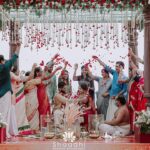In the Jacobite community of Kerala the traditions are woven with cultural rituals of the Hindus and their faith stems from the Syrian Christians. Interestingly the number seven has great significance to them as it does within other Indian wedding ceremonies.
Jacobite wedding ceremonies are not long as other religions. There are five important ceremonies in Jacobite Christian weddings. Let us explore the wedding Rituals of Jacobite Christians.
ARRANGING A MATCH
- Kalyanamaurappa:
‘KALYANAMAURAPPA’ means ‘arranging a marriage’ between the girl and the boy. Once the groom’s family accepts the proposal, male members from the groom’s family visit the bride’s family to fix a wedding date. Both families take a decision that the girl will come to into the boy’s family along with ‘STREEDHANAM’ (wealth of a woman), which can include money, clothes, jewellery or property. Henceforth she will not lay any more claims on her father’s wealth. Once an agreement is reached, the two eldest male members from each family hold hands in a symbolic clasp.
An ‘ANGAVASTRAM’ (white cloth) covering their hands, seals the contract. The engagement is announced at the respective churches for three consecutive Sundays in the presence of the community and the families of the bride and groom. On the third Sunday, the bride and groom go to their respective churches for confession and to partake in the Holy Communion.
PRE-WEDDING RITUALS
- Madhuramvekal:
This ceremony is held in the respective homes of the bride and the groom, a day prior to the church wedding. Barring a few differences, the ceremonies are similar.
The groom sits facing the east, while a barber cuts his hair and shaves off his beard. The groom’s eldest sister or female cousin anoints his hair with oil. The groom’s brother-in-law then escorts the groom for his regular bath ensuring that he does this from the westerly direction. The groom returns from the easterly direction, sheltered under an umbrella, held by the brother-in-law. On his arrival, all the ladies clap their hands and cheer him. This is called the ‘KORAVA’, traditionally considered very auspicious throughout Kerala.
In the bride’s home, she is made to wear a simple sari and her brother’s wife performs the rituals of anointing her with oil and taking her for her bath in the same manner as done for the groom. After her bath, the bride changes into a resplendent silk sari, wears traditional jewellery; adorns her hair with flowers and puts on a gold chain with a cross on it.
After the ‘KORAVA’ the bride and groom in their respective homes, heads covered, sit on a chair, which has been covered with a white cloth and are blessed by the priest. A sweet called ‘MADHURAM’ (banana slices soaked in sweet Palmyra palm juice) is brought to be blessed by the priest. After the blessing, the sweet is given to the bride and the groom by the mother or grandmother.
- Mantra Kodi: Preparing The’ Taali’
The sari, which the groom will present to his bride in church the next morning, is called the ‘MANTRA KODI’. The night before the church ceremony, Seven threads are taken from the wedding sari and spun together with either candle wax or rice starch. These are used for the minnu which is a small leaf shaped pendant made of gold, it has seven tiny beads placed together on the leaf to form a cross. The number seven represents the completion of creation in its perfect state.
HOLY MATRIMONY / WEDDING CEREMONY
- Church Ceremony:
The groom will be waiting at the church with his bestman and ushers – his beautiful veiled bride will walk down the aisle on her father’s arm in the long held tradition of ‘giving away’. The priest takes the right hand of the bride and places it on the groom’s right hand. After this, the priest reads some passages from the Bible in reference to marriage; the couple holding hands while exchanging vows.
Rings will be exchanged – this originates to the time of Abraham. The roundness of a ring symbolises an eternal promise of love and faithfulness between a man and a woman
The minnu is tied around the bride’s neck by the groom with a ‘reef knot,’ symbolising strength and permanence of marriage. The reef knot is tied as left over right and right over left. After seven days of marriage, the minnu is strung on a gold chain and is expected to be worn till death. During this ritual the priest will say prayers.
After the blessing, the bride and the groom step out of their homes, preceded by a young girl holding a ‘DIYA’ or lamp. The bride wears cream coloured Kerala sari. In the church the priest officiates and after the sermon, the couple exchange wedding bands. All through the ceremony the bride’s sister stands behind her. Vows are exchanged and the groom ties the ‘TAALI’ to the bride. During the tying of the ‘TAALI’, the bride’s sister is replaced by the groom’s sister.
The ‘MANTRA KODI’ is placed on the bride’s head by the priest and blessed. Later, the bride puts the sari on her left hand. The same sari is worn by her for the reception. The couple joins hands and is announced man and wife.
POST WEDDING CELEBRATIONS
- Reception:
The reception is a modern day concept, borrowed from the West and is basically a celebration of the wedding. The families involved host a grand dinner and the newly wed couple is introduced to the relatives and guests.







